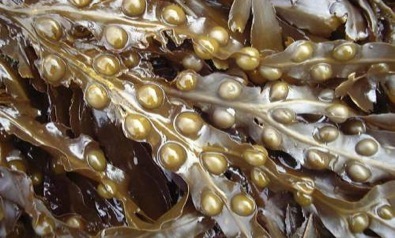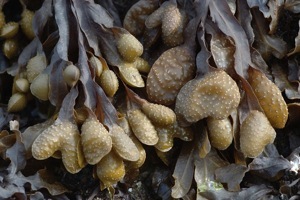Fucus vesiculosus: Edible Bladderwrack
Bladderwrack can wrack your brain.
Why? Because in some places it has bladders and is textbook perfect. And in others places it has few bladders and makes the pictures look wrong but also textbook perfect. Why? Because the numbers of bladders varies with wave action. Less waves mean more bladders, more waves, less bladders. But best of all Bladderwrack is nutritious, edible raw and cooked. It’s also medicinal, and like many things that have a medicinal applications, the flavor is strong.
Also called seawrack and rockweed, it can be used sparingly in soups and the like, depending upon your like or dislike of the flavor. It tastes like salty fish. Bladderwrack can also be dried for future use. On dehydration it turns black. (Slow roasting after drying with a little oil until brittle helps.) In large amounts it can be laxative. And of course, it can be eaten raw though try to get it in ocean waters not fertilized by human waste. It has also been used as fertilizer, being high in potassium, and also to smoke meat and fish.
Fresh it is green to orange to olive to brown, the brighter the fresher. Found between high and low tide, it lives three years and is firmly attached to the bottom, preferably to rocks usually in northern waters. To my knowledge, all Fucus are edible, but they vary significantly in description and will grow in the came locale. Consult you local expert. Sagassum used to be Fucus, such as the F. natans, but now has its own genus and is Sagassum natans (see the Sagassum entry.)
Fucus vesiculosus has been well-researched. It’s rich in dietary fiber, antioxidants and iodine. (In 1811 iodine was discovered in Fucus, the original source for it.) Bladderwrack lowers plasma cholesterol levels and has been used in anti-estrogen therapy, actually increasing the length of the menstrual cycle. (See Herb Blurb below.)
Fucus (FEW-cuss) comes from the Greek word “phykos” (FEE-kos) meaning seaweed. Vesiculosus (ves-see-kew-LOW-sus) is Latin and means with bladder. Natans (NAY-tanz) is floating. Fucus is sometimes incorrectly called kelp. In the past several seaweeds were burned to create soda ash which was called “kelp.” The seaweed kelp and the Fucus are different seaweeds.
Green Deane’s “Itemized” Plant Profile
IDENTIFICATION: A perennial attached sea-weed, with a hard flattish root, frond ranges from a few inches to four feet in length, and to an inch in width, flat with midrib throughout length, occasionally twisted like a spiral, branches often notched at the end. Air sacks vary from the size, from a pea to a marble, in pairs, at irregular intervals; sometimes 2 or 3 pairs are next to each other, rarely totally absent.
TIME OF YEAR: Year round
ENVIRONMENT: Shoreline, between high and low tides, prefers protected areas. Found in northern waters, in the United States North Carolina and central California northward. Usually collected at low tide.
METHOD OF PREPARATION: Raw or cooked, boiled or steamed, can be dried, strong flavored.
HERB BLURB
Bladderwrack contains: Iodine, algin, mucilage, bromine, sodium, potassium, lutein, zeaxanthin, chlorophyll, cellulose, mannitol, silicon, essential fatty acids, vitamin C, B-vitamins, beta-carotene, zinc, magnesium, selenium, manganese, iron, phosphorus, iodide, oleic acid, polyphenols, protein and fiber.




